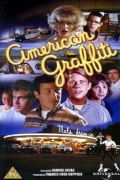
Directed by
George Lucas
110 minutes
Rated PG
Reviewed by
Bernard Hemingway

American Graffiti
After his critically unloved (and generally under-rated) sci-fi feature debut THX 1138 (1971), George Lucas, with the assistance of Francis Ford Coppola, made this nostalgia-fest based on his own youth. Made for only $750,000, not a lot of money even in its day, it grossed over $50m and made Lucas one of the hottest of the “New Generation” of young directors then emerging in Hollywood. That he followed it up with the even more successful Star Wars (1977) indicates how much he was a man for his times.Released just as the Vietnam war was ending with a spectacular defeat for the US and Watergate was coming to light, American Graffiti looks back to the glory days of bobby soxers and teeny-boppers, soda fountains and hot cars, a world that ended brutally with the assassination of President Kennedy in 1963.
Scripted by Lucas with Gloria Katz and William Huyck (who would go on to make the disastrous Lucas-produced Howard The Duck in 1986) it is a neatly-drawn portrait of '50s teenagers (although set in the early '60s it is much more characteristic of the previous decade) saying farewell to their childhood and reluctantly facing the world of adulthood.
Starring eventual marquee players Richard Dreyfuss, Ron Howard (who went on to become an A-list mainstream director) and Harrison Ford amongst now less well-known names, the film is skilfully lensed by Haskell Wexler. Aside from its endearing mythologizing of American teen archetypes, much of the success of the film is due to its then innovative soundtrack, a nearly back-to-back series of Top 40 hits from the doo-wop and early rock-n’roll era, a technique which carried over to successors like Diner (1982) and The Big Chill (1983).
On the back of its success, Ron Howard went on to star in the long-running sitcom, Happy Days (The Fonze was a cleaned-up version of the Bo Hopkins character here) whilst Cindy Williams had much success with another spin-off, Laverne and Shirley. In this latter respect one of the anomalies of the film, albeit appropriate enough to the time in which it is set is that the female characters get so little attention, with the end titles telling us the fate of the four males but not mentioning the latter. Fortunately, five years later, Grease would make amends.
FYI: There was a sequel, More American Graffiti released in 1979, written and directed by Bill L. Norton that although having pretty much the same cast, tanked.
Want something different?





